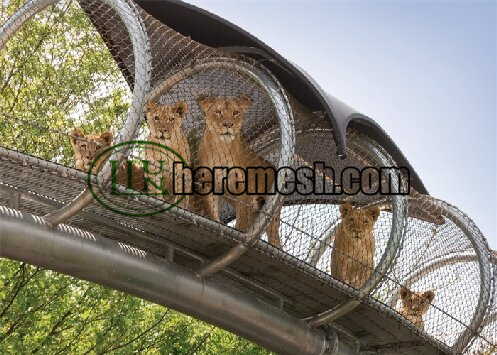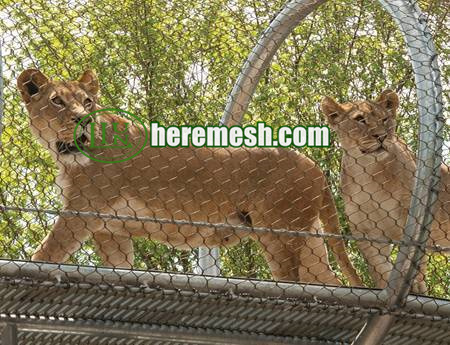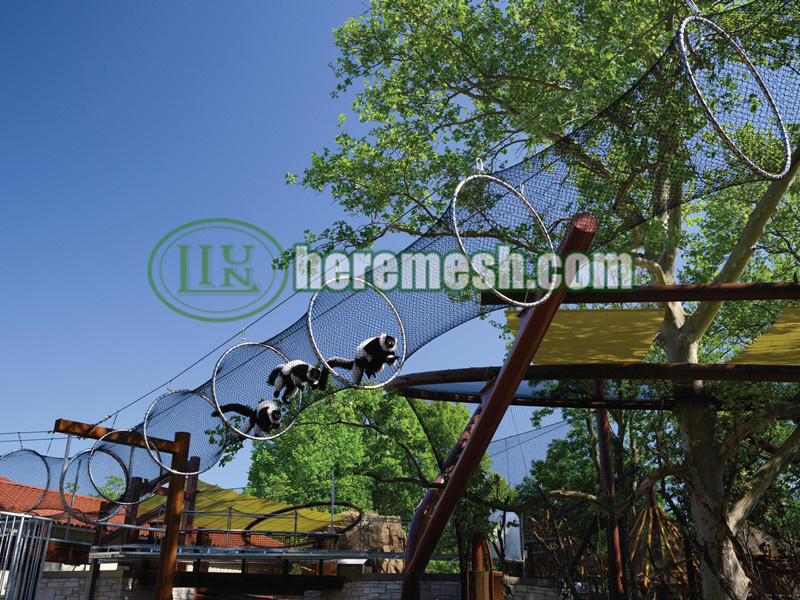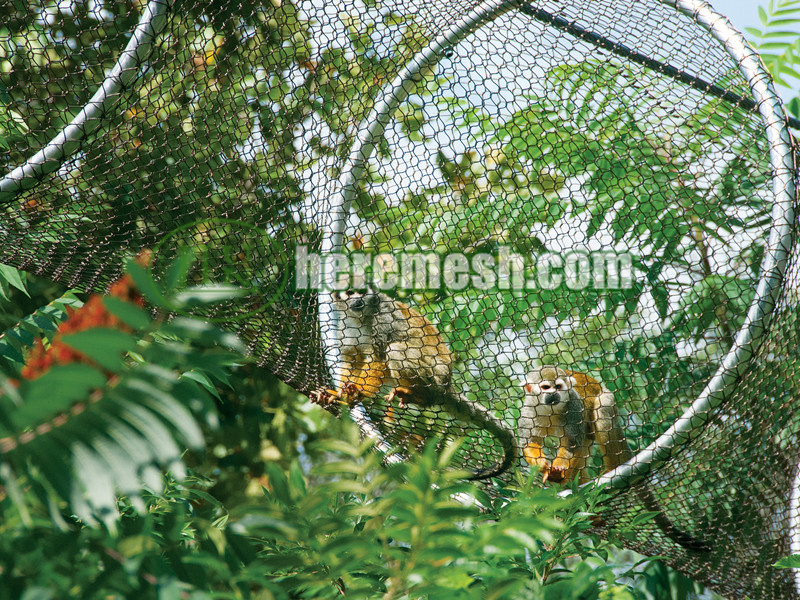Safety and Aesthetic Integration in Modern Zoo Tunnel Mesh

Stainless steel netting in modern architecture and industry
06/17/2025
Premium Stainless Steel Hand Woven Multiple Wire Mesh
06/26/2025The concept of stainless steel zoo tunnel mesh
In modern zoo design, the safety isolation system for animals and visitors plays a vital role. Stainless steel zoo tunnel mesh as the core component of this system. The access mesh assumes the basic safety function and also reflects the comprehensive consideration of animal welfare in modern zoo design concepts. The mesh structure is made of high-quality stainless steel, which provides excellent durability, corrosion resistance and visual permeability.
Stainless steel access mesh has changed the traditional closed zoo isolation method. Early zoos mostly used simple iron fences or concrete walls as a means of isolation. Although the traditional zoo can meet the basic safety needs, it creates a visual barrier that affects the viewing experience of visitors. This approach also has a negative impact on animal psychology and is not conducive to the development of animal welfare. The application of stainless steel zoo tunnel mesh minimizes the visual obstruction. It allows visitors to have a nearly unobstructed viewing experience. The channel mesh connects the exhibits and provides a more natural living environment for the animals.
From a technical point of view, stainless steel zoo tunnel mesh is a mesh structure made of stainless steel wire through precision weaving process. The mesh aperture can be customized and produced according to different application scenarios and protection needs. This flexibility allows designers to customize the most appropriate protection solution based on the size, behavioral characteristics and strength of different animals. For large cat areas, thicker steel wires are usually used. For bird exhibits, on the other hand, finer wires can be used to balance safety and spectacle.
The Importance of stainless steel zoo tunnel mesh
Analyzed from a functional point of view, the stainless steel zoo access mesh is a multifunctional integrated system. It is not only a physical isolation barrier, but also a connection system for each exhibition area. The zoo tunnel mesh effectively separates different animal habitat areas and connects different exhibition areas. This design ensures the safety of visitors and animals, and also expands the activity area of animals.
At the zoo management level, stainless steel zoo access mesh also offer significant operational advantages. Its durability reduces the cost of frequent replacement and maintenance. Its easy to clean simplifies the daily hygiene work. Its aesthetic appeal enhances visitor attractiveness. Its robust and reliable mesh structure alleviates safety concerns for managers. From the whole life cycle cost calculation, these advantages work together to make the stainless steel access mesh has better economy.
The use of access mesh transforms the zoo concept from simple animal display to animal protection. The construction of the passageway mesh enhances the welfare of the animals and raises the public awareness of the visitors to protect the wildlife.


Reliable stainless steel zoo tunnel mesh
The fundamental reason why stainless steel zoo access mesh stands out from the crowd as the preferred choice for modern zoo design is due to the range of excellent properties of the stainless steel material itself as well as the advanced manufacturing process.
In terms of material composition, zoo tunnel mesh is usually made from 304 or 316 grade stainless steel. 304 stainless steel and 316 stainless steel both have good corrosion resistance. Stainless steel rope mesh is more suitable for zoo construction due to its flexibility and resistance to compression. Both materials excel in mechanical properties, with 316 stainless steel having greater tensile strength than 304 stainless steel. This is strong enough to withstand the impact and tearing of most zoo animals. More importantly, stainless steel has good toughness and does not become brittle even at low temperatures. This property ensures the reliability of the enclosure in extreme weather conditions.
The surface properties of stainless steel are another great advantage. With proper surface treatment, stainless steel tunnel mesh can be obtained in different visual effects from primary color to black. Different colors can meet the needs of different places. In terms of corrosion resistance, stainless steel tunnel mesh performs much better than traditional galvanized wire mesh. Under the same environmental conditions, the average service life of ordinary galvanized wire mesh is about 5-8 years, while the service life of 304 stainless steel mesh can reach more than 20 years. 316 stainless steel mesh can even reach 30 years or more. The corrosion resistance of stainless steel is an inherent characteristic of the material, unlike the galvanized layer that will gradually deplete over time.
Animal behavior and design of zoo tunnel mesh
The design and application of stainless steel zoo tunnel mesh is a complex subject that requires an in-depth understanding of animal behavior, psychology and welfare needs. The modern zoo concept emphasizes providing animals with an environment as close to nature as possible. This helps to facilitate their display of natural behaviors. Stainless steel tunnel mesh plays a key role in the realization of this philosophy. Scientifically designed enclosure systems not only ensure safety, but also positively influence the behavioral patterns and psychological well-being of the animals.
Different animal species have very different ways of perceiving and interacting with fences. The design of stainless steel channel mesh must fully consider these species-specific behaviors. For bear exhibits, the fence needs to have higher structural strength and anti-vandalism design. For primates, it is necessary to pay more attention to the integration of anti-climbing characteristics and environmental enrichment.
The visual characteristics of fences also have a profound impact on animal behavior. Traditional dense fences tend to create a “cage consciousness” in animals, leading to stereotypical behavior. Stainless steel tunnel mesh minimizes visual obstructions while providing the necessary safety barriers, allowing animals to see a wider view of the external environment. This visual permeability helps to reduce the animal’s sense of oppression and promotes more natural behavioral expression.


Three-dimensional space design and animal behavior promotion
The way in which animal habitats are spatially arranged also influences animal behavior patterns. Modern zoo design increasingly favors the use of stainless steel passage mesh to create three-dimensional spaces rather than just flat enclosures. Access nets designed for arboreal animals will extend the habitat to a high level, creating a structure that can be climbed. This three-dimensional spatial design allows the animals to choose areas of varying heights and levels of privacy to suit their needs, thus exhibiting a greater variety of natural behaviors. This design is also conducive to animal interaction, creating more interactive channels for animals.
Long-term studies have shown that scientifically designed stainless steel access mesh systems can significantly enhance the welfare of captive animals. By increasing the expression of natural behavior, promoting social interaction and other aspects of the role of the zoo concept gradually changed from simple animal protection to enhance animal welfare.
Stainless steel zoo tunnel mesh for safe design and visitor experience
Zoo access must be designed to meet both the highest level of safety requirements and to optimize the visitor experience. The most fundamental aspect of a safe design is the strength of the mesh to withstand the maximum strength of the animal’s impact. This is followed by anti-climbing measures, a design that not only prevents the animal from escaping, but also avoids the risk of injury if the animal climbs too high and falls. Access nets are usually made with smaller mesh holes to prevent the animal’s claws from reaching out and attacking visitors. These design details play a key role in preventing accidents.
From the perspective of visitor experience, visual permeability is the most direct experience factor. High-quality stainless steel mesh can achieve a high rate of visual permeability. This means that visitors can hardly feel the presence of the mesh and have a nearly unobstructed viewing experience. The mesh is often available in a black finish to avoid reflections interfering with viewing or causing uncomfortable glare.
Spatial awareness design influences visitor immersion through the way the stainless steel zoo tunnel mesh is arranged. Modern zoos tend to use a three-dimensional design, a layout that not only fits better with the aesthetics of the natural landscape, but also creates a greater sense of spatial depth. Such designs allow visitors to observe animal behavior at different distances. These innovative designs allow visitors to feel as if they are in the space where the animals are moving.
Reasonable maintenance: to protect the performance and beauty of zoo tunnel mesh
Long-term maintenance is critical to keep stainless steel access performing and looking great. Although the stainless steel material itself has excellent corrosion resistance, it still requires regular cleaning and inspection in the specialized environments of zoos. Modern designs take into account ease of maintenance, such as easy-to-open access ports, modular design for local replacement, and surface treatments. Good maintenance not only extends the life of the facility, but also ensures that visitors always have the best possible viewing experience.
Conclusion
The excellent corrosion resistance, structural stability and design flexibility of stainless steel zoo tunnel mesh allow it to adapt to complex environmental requirements. It balances functionality and visual aesthetics, providing benefits for animals and a new visual experience for visitors. Through scientific maintenance management, humane design optimization and the integration of new technologies, stainless steel passageway mesh will continue to promote the development of zoos in a safer and more educational direction.


